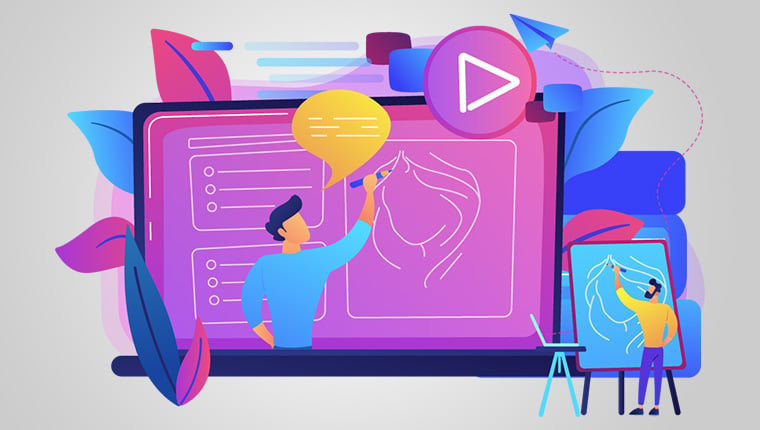A Visual Design Model for Planning Your eLearning Courses Systematically

T his might seem rather obvious, but why should you use graphics/visuals in training materials at all? Isn’t the content enough in itself? The answer to these questions is simple: our brains are wired to learn visually and having rich visuals in training materials – including eLearning – makes learning far more engaging.
Why do most companies get it wrong? At one extreme, we have eLearning courses that use elaborate visual elements embedded in dry and disengaging content. On the other, there are courses with visuals which are merely decorative. The common thread that joins them is the lack of an instructional purpose behind using the visuals.
3 Elements to Ensure You Get the Visual Design for eLearning Right
- Define the goal of the eLearning course
- Determine the context of the training program
- Apply principles of psychological instructional events to visual design decisions
Ruth Colvin Clark and Chopeta Lyons in “More Than Just Eye Candy: Graphics for eLearning” write on why online learning often fails to leverage visuals:
Because it’s such a visual medium, it’s too bad that eLearning so often fails to leverage the potential of graphics to promote learning… Because words are quick and easy to produce, and because we have all devoted lifetimes of learning and practice perfecting our use of language, all too many eLessons [eLearning courses] include no visuals or at best, only a few decorative visuals.
It is safe to say that this one aspect of instruction has remain untapped in eLearning courses, especially due to the lack of information around what constitutes good graphic design.
In this blog, we will look at Clark and Lyons’s visual design model that will help companies systematically plan and design their graphical/visual strategy to best support their training’s instructional needs, and at the same time come to terms with the underlying importance of graphic design in general.
Without any further ado, let us look at the visual design model.
Understanding Visual Design for eLearning
1. Define the goal of your eLearning course
The goal of your eLearning course determines the direction of its graphic design process. What is the goal of your eLearning course? Is it to:
- Build awareness
- Teach procedural skills
- Impart problem-solving skills
Most eLearning courses revolve around these three goals. Let’s take the example of a training program intended to teach learners how to use a software tool/system and perform debugging procedures. Learners are then expected to be able to use the software efficiently at work to locate and fix bugs in the real world. These are procedural courses which have enabling-goals to inform learners about the tool and the benefits it may bring them at work.
To train learners on procedures, a detailed textual description displayed on a non-interactive slide is no clever option. On the other hand, guided simulation, a common method to teach computer-related procedures, is. Use short demos to teach procedures being broken down into tasks. You could think of a simulation that shows learners how to perform the task (here, how to perform a debugging procedure). Follow through with a practice session that lets learners practice their skills.
For non-computer-related procedural trainings, the strength of visuals can be leveraged to demonstrate the procedure. For example, an online learning course on safe lifting practices will benefit hugely from visuals that can convey the unsafe practices and also display the steps for safe lifting.
2. Determine the context of the training program
Determining the context involves defining your learners; the environment they will access the learning content in; their preferred delivery medium (such as mobile device, computer screen or hard copies of PDFs); and also your organizational constrains (budget, resources and deadlines). These four factors decide the type of visuals that will end up in the training. Let’s go over each of them in detail.
(A) Online learning programs are designed for specific groups of learners whose backgrounds and aptitudes shape decisions about visuals drastically. Determine how much prior knowledge the audience has about the training content. For example, visual aids are known to break the cognitive load on novice learners than on advanced learners — with the help of diagrams and plots, the otherwise-notoriously difficult content becomes easy to comprehend.
(B) Evaluate their working environments and the workspaces they work in. If learners work in noisy environments, you may want to use less of audio and more of onscreen text and visuals. On the other hand, if they are constantly traveling from place to place, a podcast that won’t demand too much of their attention will do the job.
(C) Pick a good delivery medium. Most often, this decision is either going to make or break your training. Not all delivery strategies have similar visual design strategies. For example, when it comes to mobile learning, courseware designers ought to take into consideration the display size and dimensions of the mobile devices before deciding on the visual design strategy.
They should take proper care not to use highly ornate graphics or animations which may frustrate the learner with their load times and interactivities such as drag and drop that are not touchscreen friendly.
On the other hand, if the course needs to be presented as handy job-aid as a PDF, a series of screenshots with textual description on each page that summarizes the action would be one of the ideal choices.
(D) Also, be mindful of the practical realities of any training program—budget, organizational standards and guidelines, and resources for designing visually-pleasing eLearning courses. It would be a huge waste of time and resources if there is no financial support to back the visual strategy for your training material. Always consult your IT administration and evaluate the existing technical infrastructure (if the visuals are being developed in-house) and budget.
Note: If you are hiring a rapid eLearning vendor to design your eLearning projects, then the aforementioned steps are taken care by their team of learning and design experts, and instructional designers. But of course, your subject matter experts and other stakeholders will still be involved throughout the design process to provide their valuable inputs.
3. Apply principles of psychological instructional events to visual design decisions
This phase focusses on the layout of individual graphics within the template. Here, the focus is on how to best use visuals to avoid the cognitive load of learners without disrupting learning. The layout of visual elements in your online course is responsible for directing the learner’s learning such as:
- Graphics for cueing
- Whitespace to add emphasize and eliminate distraction
- Proximity or grouping to provide visual contiguity or show relationships
In eLearning, however, psychological principles can also be applied. For example, in an online software training course, you may decide to use animations to demonstrate processes. But it is highly possible for animations to cause cognitive overload among learners. Therefore, to help learners overcome or avoid the mental overload altogether, audio narration and not onscreen information will simplify the learning process. The learner will also be given control over the learning process through the playback control buttons such as pause and replay right on the screen.
Concluding Remarks
Systematically planning the look and feel of graphical elements—one that is not too elaborate nor something that is over-simplified for your online learning courses—will surely ensure learners find it easy to assimilate the knowledge being presented. When you have a good visual design strategy in place, it reduces the chances of rework on the final output.
As we have discussed in the blog, the best visual design strategy for your training depends on an interplay among training goals, properties of the learning environment—including the training setting, the delivery media, and the learners who will participate.





